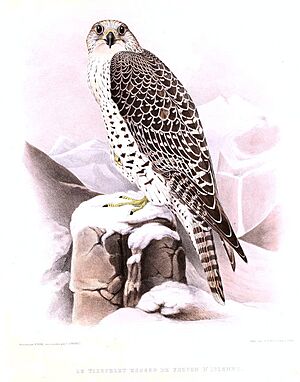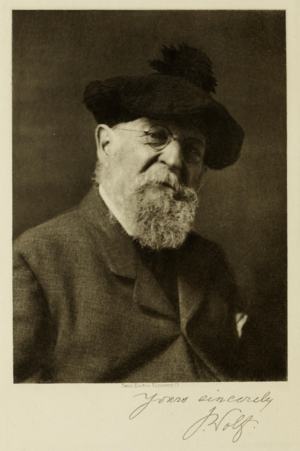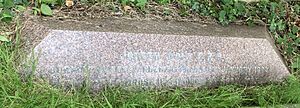Joseph Wolf facts for kids
Quick facts for kids
Joseph Wolf
|
|
|---|---|
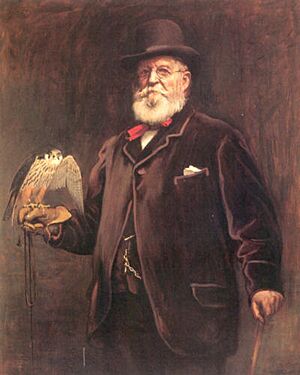
Joseph Wolf with a Eurasian hobby (Falco subbuteo)
|
|
| Born | 22 January 1820 |
| Died | 20 April 1899 (aged 79) |
| Nationality | German |
| Known for | Natural history illustration |
|
Notable work
|
340 illustrations for ZSL Proceedings |
Joseph Wolf (born January 22, 1820 – died April 20, 1899) was a German artist. He was famous for drawing animals and plants for scientific books. This is called natural history illustration.
In 1848, he moved to the British Museum in London. There, he became the favorite artist for famous explorers and scientists. These included David Livingstone and Alfred Russel Wallace. Joseph Wolf drew animals very accurately. He showed them in lifelike poses. Many people see him as one of the first great wildlife artists. Sir Edwin Landseer, a famous painter, called him "the best all-round animal artist who ever lived."
Contents
Early Life in Germany
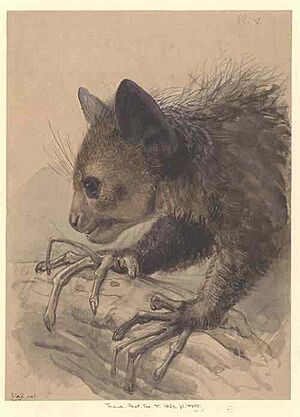
Joseph Wolf was born in a small village called Mörz in Germany. His father was a farmer. From a young age, Joseph loved studying birds and other animals. He was very good at drawing them.
He showed his artistic talent early on. He would cut out paper shapes of birds and animals. Then he would stick them onto windows. He also enjoyed hunting. He even made his own paintbrushes from animal fur. He drew pictures of birds he found or raised. He was especially interested in birds of prey.
At 16, Joseph realized he needed more training to become a professional artist. His father helped him get an apprenticeship. He worked for a company that made lithographs in Koblenz. Lithography is a printing method using a stone or metal plate. Here, he saw his first book of bird illustrations. He was surprised by how poor the drawings were.
Starting His Art Career
After his apprenticeship, Wolf traveled to Frankfurt. He met a bird expert named Eduard Rüppell. Rüppell was working on a book about birds from Africa. He encouraged Wolf to draw for him. Wolf then moved to Darmstadt. He continued to work on Rüppell's bird book.
Another scientist, Johann Jakob Kaup, was very impressed by Wolf's skills. Kaup showed Wolf's drawings to Hermann Schlegel in the Netherlands. Schlegel immediately asked Wolf to create drawings for his book, Traité de Fauconnerie. This book was about falconry, which is hunting with falcons.
Wolf created "magnificent paintings of birds of prey." These were life-sized and very detailed. These drawings made him famous across Europe.
Wolf was a keen observer of wild birds. He once dug a pit and sat in it all day. He wanted to watch the courtship dance of black grouse. In 1847, he went to the Antwerp Academy. He wanted to learn how to paint with oil paints. Around this time, Wolf was invited to London. He was asked to illustrate a book about bird types for George Robert Gray.
Life and Work in London
Joseph Wolf arrived in London on March 20, 1848. He quickly started working on Gray's book, The Genera of Birds. While at the British Museum, he met other scientists. He became friends with William Russell, who introduced him to famous people. These included Sir Edwin Landseer and the Duke of Argyll. The Duke became a supporter of Wolf's art. Wolf's paintings were also admired by a group of artists called the Pre-Raphaelite Brotherhood.
John Gould, another famous bird expert, wanted Wolf to work for him full-time. But Wolf preferred to work independently. Wolf did go on a collecting trip to Norway with Gould. Wolf felt that Gould was not very good at drawing feather patterns or creating good compositions.
The Zoological Society of London asked Wolf to paint a watercolor of wapiti deer in the snow. This painting is from January 1881. Soon, Wolf became the top choice for illustrating books by explorers. These included David Livingstone, Alfred Russel Wallace, and Henry Walter Bates. For example, he illustrated Bates' 1863 book, The Naturalist on the River Amazons.

Wolf joined a group called the German Athenaeum. Members met for scientific, literary, and musical evenings. He created many artworks for their exhibitions. His favorite materials were charcoal and ink.
When Charles Darwin was studying animal expressions, he learned about Wolf's skills. Darwin asked Wolf to draw animals from photographs and from live animals at the zoo. Wolf had his own ideas about how animals showed emotions. He even questioned Darwin's idea that a monkey's face looked like a "laugh." Darwin visited Wolf many times. Wolf liked Darwin because he was easy to talk to, even for a child.
Wolf's Legacy
Joseph Wolf's artistic skills were highly praised during his lifetime. He helped establish wildlife art as a respected type of art. He watched living birds very closely. This allowed him to draw them in very accurate and lifelike positions. Sometimes, he could even draw accurate sketches from memory after a trip. He paid great attention to feather patterns.
The scientist Alfred Newton called him "the greatest of all animal painters." Landseer said that Wolf "must have been a bird before he became a man." Wolf made many drawings and lithographs for scientific groups. He created 340 colorful drawings for the Zoological Society of London over 30 years. He also illustrated many books about nature and travel. He was also a successful painter.
For many years, the cover of the journal Ibis featured a woodcut by Wolf. It showed an ibis bird with a background of ruins and a rising sun.
Joseph Wolf passed away in London in 1899. He was surrounded by his pet birds. He is buried in Highgate Cemetery.
In 2002, a new road in his hometown of Mörz was named "Joseph Wolf Weg" (Joseph Wolf Way) in his honor. In January 2020, his 200th birthday was celebrated with a "Joseph Wolf year" in Mörz.
Images for kids
-
Joseph Wolf with a Eurasian hobby (Falco subbuteo)


